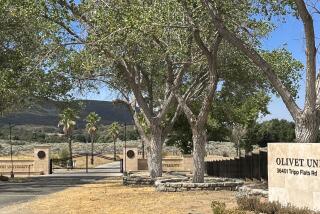Texas corp fielding more unwanted notoriety : A & M cadet program, no stranger to controversy, is facing renewed charges of sexual harassment.
COLLEGE STATION, Tex. — In a year in which sexual harassment has jumped into the headlines, the Aggies of Texas A & M University find themselves in an uncomfortable spot: front and center.
The corps of cadets of A & M, long the symbol of this sprawling campus, is under university investigation over allegations that male cadets denigrate and harass the small number of women who have joined the corps.
John Sherman, the top-ranking member of the corps, likens the investigation to being under a microscope. The comparison is apt, because the group appointed by A & M President William Mobley is making its way through a long list of witnesses trying to find out what goes on inside the corps.
Last September, a sophomore woman cadet charged that she had been beaten up by male cadets trying to dissuade her from joining an elite cavalry outfit of the corps. That was followed a month later by the allegation that she was beaten again.
It was followed by her sudden recantation of both events. But her charges had prompted an investigation that found enough evidence of wrongdoing that three students were ousted from the corps and three more were disciplined.
That might have ended the matter were it not for the fact that others had stepped forward by then with stories of their own. Four women, present and former cadets, met with Mobley to give their versions of cadet life, which ranged from rape to being repeatedly subjected to obscene language.
One woman, who is of Asian descent, said she was humiliated when forced to sing Jingle Bells with a Chinese accent during formation and to buy condoms for upperclassmen. In addition, she said, she had been called numerous derogatory names by male cadets.
Another described how male cadets consistently refused to shake hands, which in corps parlance is called “whipping out.” She also said she knew of an incident in which male cadets threw a laundry bag over a female cadet and then took her to a secluded area where she was kicked and then raped.
The corps response to the latter was that no one had ever reported such an incident previously.
This type of accusation comes at a time when the awareness of sexual harassment is on the rise and the corps is on the decline. A & M boasts that it produces more military officers than any place except for the service academies, but the corps now represents less than 3% of the 41,000 students who attend the university.
“We have to beat the bushes to find people to join the corps,” said Kurt Sauer, the deputy commander of cadets.
For many years, being in the corps was compulsory for all students attending A & M. And until 1963, all of those students were men. The corps had a tradition of hazing going back to the 19th Century, just as it had a reputation for producing quality military men. Aggies are often the butt of jokes on other Texas college campuses, but the university has increased its enrollment by 500% since 1968 and has become a first-class academic institution.
Now, however, the corps uniform on campus has become more the exception than the rule. But the uniform still remains the symbol of the school, especially the one worn by seniors, who sport knee-high boots and spurs.
This is not the first time the corps has had its share of unwanted notoriety. In 1979, the American Civil Liberties Union sued on behalf of a student, Melanie Zentgraf, who was trying to become the first woman admitted to the corps’ all-male elite units. The women cadets then testified to getting obscene phone calls by male cadets, finding dead animals in their rooms, mooning by male cadets and other forms of harassment.
Then-A & M President Jarvis Miller refused to shake hands with Zentgraf at graduation.
In other incidents, corps members had to be restrained from attacking the Rice University band in 1973 after members goose-stepped around the field in a parody of the cadets. At another game in 1981, a corpsman brandished his sword at Southern Methodist University cheerleaders. And in 1984, the focus was on the corps when a freshman died during a hazing incident.
How this latest episode will end up depends on the findings of the investigators. Sherman insists it is all a matter of a “few bad apples” and also suspects some sort of conspiracy to embarrass the corps.
A & M psychology professor Wendy Stock, the faculty adviser to the campus chapter of the National Organization for Women and a backer of the probe, replied: “I’ve got better things to do than undermine the corps.”
Whatever the outcome, it has already produced some bizarre twists, including the public naming of one of the women who discussed her experiences in confidence witM president.
“I feel violated,” said the woman, a fifth year senior who hopes to receive her Army commission in May. She also said she did not want to see the corps disbanded, as some have suggested.
“I don’t want to see it disbanded because it’s part of the school,” she said. “But they are undermining themselves because of their actions.”
More to Read
Sign up for Essential California
The most important California stories and recommendations in your inbox every morning.
You may occasionally receive promotional content from the Los Angeles Times.









